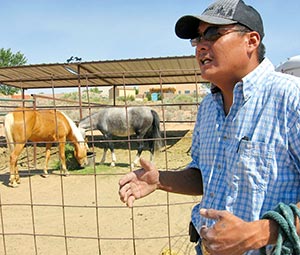Saving the sacred
Rio Rancho man dedicated to rescuing horses
By Cindy Yurth
Tséyi' Bureau
Rio Rancho, N.M., June 16, 2011

(Times photo - Cindy Yurth)
With two of his rescue horses in the foreground, Emerson Sam of Rio Rancho, N.M., talks about how he feels the Diné have lost their way when it comes to treatment of these sacred animals.
His wife, Lavern, always urges him to take "before" photos, so people will realize how far they've come. But he can't bring himself to.
"Chief, that Appaloosa, weighed 800 to 900 pounds when he came to us," Sam said. "He looked like that roping dummy over there. I don't want to remember him like that."
Now Chief is a healthy 1,300 pounds, about where a gelding his size should be. His liver-brown, white-splashed coat gleams in the sun and he eyes the visitors curiously as he munches his hay.
But even without a "before" photo, you can look around his corral and see how far he's come.
"See all those dents in the fence?" Sam said. "That was him."
Like many of the horses Sam rescues, there was a lot more wrong with Chief than being 400 pounds underweight. A victim of severe neglect, he didn't like humans much and trusted them less.
After some months with Sam, he's "a great ride" and a gentle guy who enjoys being petted by Sam's four youngsters. He's ready for his forever home.
On his acre-and-a-half in Rio Rancho, mostly taken up with a row of stalls and corrals, Sam fosters horses the way some people foster dogs. One or two at a time, he nurses them to mental and physical health, and adopts them out to friends and family members.
"I never sell them," he said. "That's not our traditional way. And I won't give them to anybody unless I'm sure they'll treat them the way I treat them."
Which is?
"The way most people would treat their Chihuahua," he said with a laugh.
It's a bit of a busman's holiday for Sam, who is a farrier and colt-trainer for his day job. But it's more of a spiritual calling.
When it comes to horses, Sam thinks a lot of Diné have lost their way.
"These animals are supposed to be sacred to us," he said. "They're not supposed to be wandering around gas stations. They're not supposed to be out in the middle of the road being hit by cars. They're not supposed to be starving because someone has more of them than they can afford to feed."
Someone who had heard of Sam and his "magic" way with horses brought him his first rescue five years ago.
"He just plain couldn't afford to feed him," Sam said. "But he should have given him up a long time ago. He was just bones."
Sam, who is Tód'k'ízhi (Salt Water Clan), born for Bit'ahnii (Folded Arms Clan), plumped the little gelding up, rode him religiously and gave him to a relative. It wasn't magic, he insists, it's just the way his father, a medicine man from Fort Defiance, taught him to treat horses.
"You feed them before you get your own breakfast," Sam said. "You ride them at least a little every day, and praise them and reward them afterward. You spend time with them, don't just turn them out in the field when they're done working for you. If you do that, they'll love to see you coming."
After being rather amazed himself at the transformation of his first rescue horse, Sam started noticing all the other neglected horses ... in corrals, limping along roadsides, reduced to eating dry leaves in the ditches of the Navajo Nation.
Although the zoning laws where he lives allow only three horses, he manages to rescue an average of two a year, often from Diné Bikéyah but sometimes from right around Rio Rancho.
Right now, in addition to a beautiful part-Arabian grey and a shiny little palomino he decided to keep, he has Chief and one other he's boarding with a neighbor.
It's a drop in the bucket, Sam knows better than anyone. But it's what he can afford, with a lot of help from his relatives, who send him checks for hay and grain and occasionally adopt one of his projects.
"I couldn't do it without my family," he said, especially his wife. "Lavern is my second hand and my best friend. If I didn't have her support, I wouldn't be doing this."
She is Naakaii Dine'é (Mexican People Clan), born for Tl'ááshchí'í (Red Bottom Clan).
What's the answer to the sprawling problem of equine abuse and neglect on the Navajo Nation? A lot more rescuers would be nice, but Sam believes education is the key.
"We need to hold a whole lot of clinics to discuss nutrition, exercise, how their feet should be, everything about horses," he rattled off as though he's been giving this a good deal of thought.
"Someone like me should bring one of their horses so people can see what a horse should look like," he said. "Even a big old hammer-headed mustang can look like this if you give it enough love.
"And it should be free. We Navajos see that big old F-R-E-E and we can't resist it, whatever it is."
After that, Sam says, he needs to win the lottery and run for Navajo Nation president so he can expand his rescue operation.
"I'll buy a great big pasture and keep all of them," he said with a grin.
The grey Arabian mare walked over to the fence and nuzzled him in affirmation.
Or maybe she was just saying, "'Ahéhee.'"

